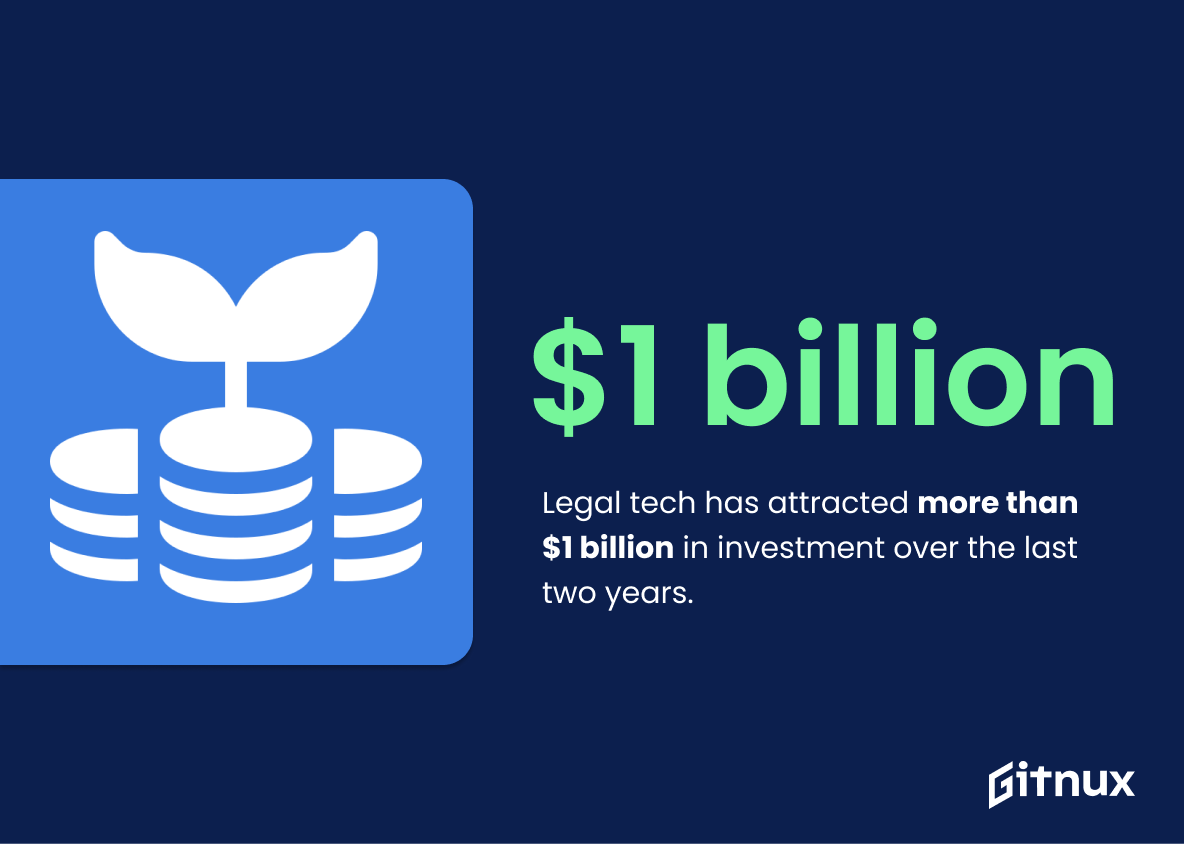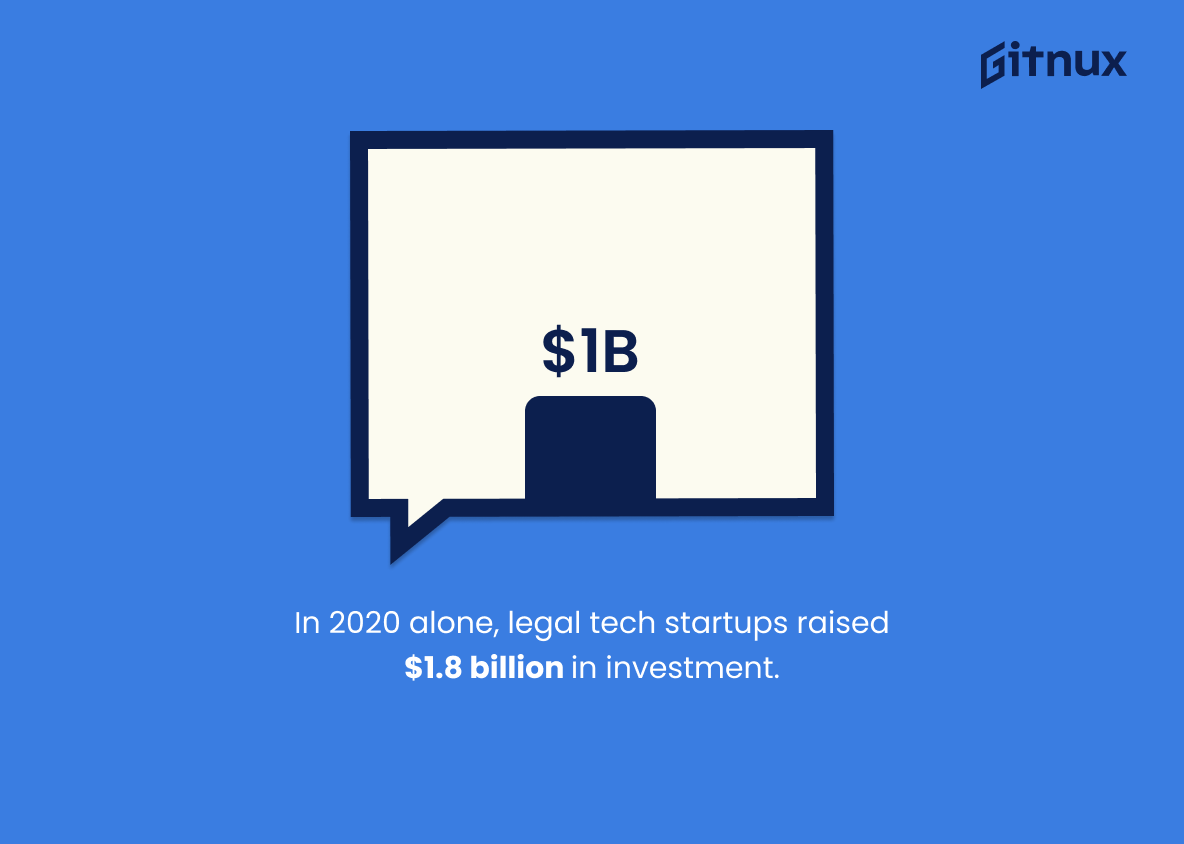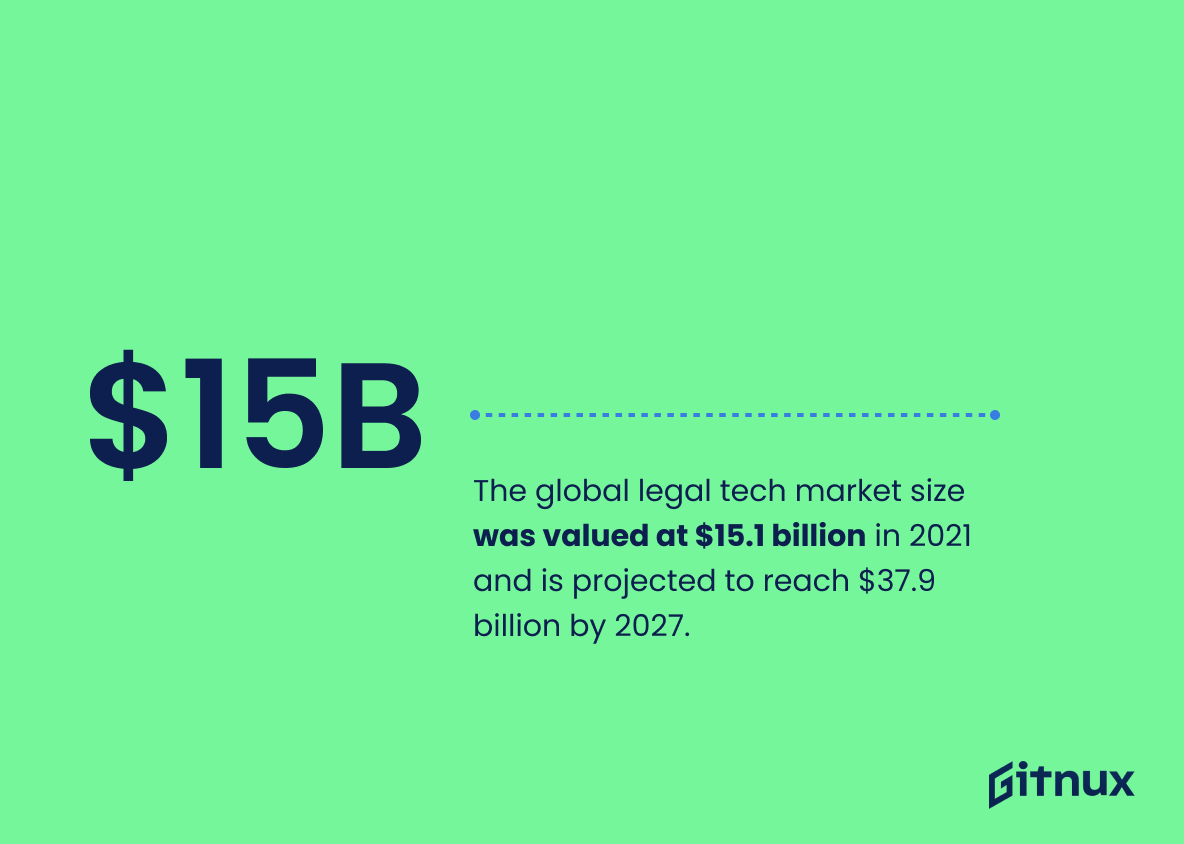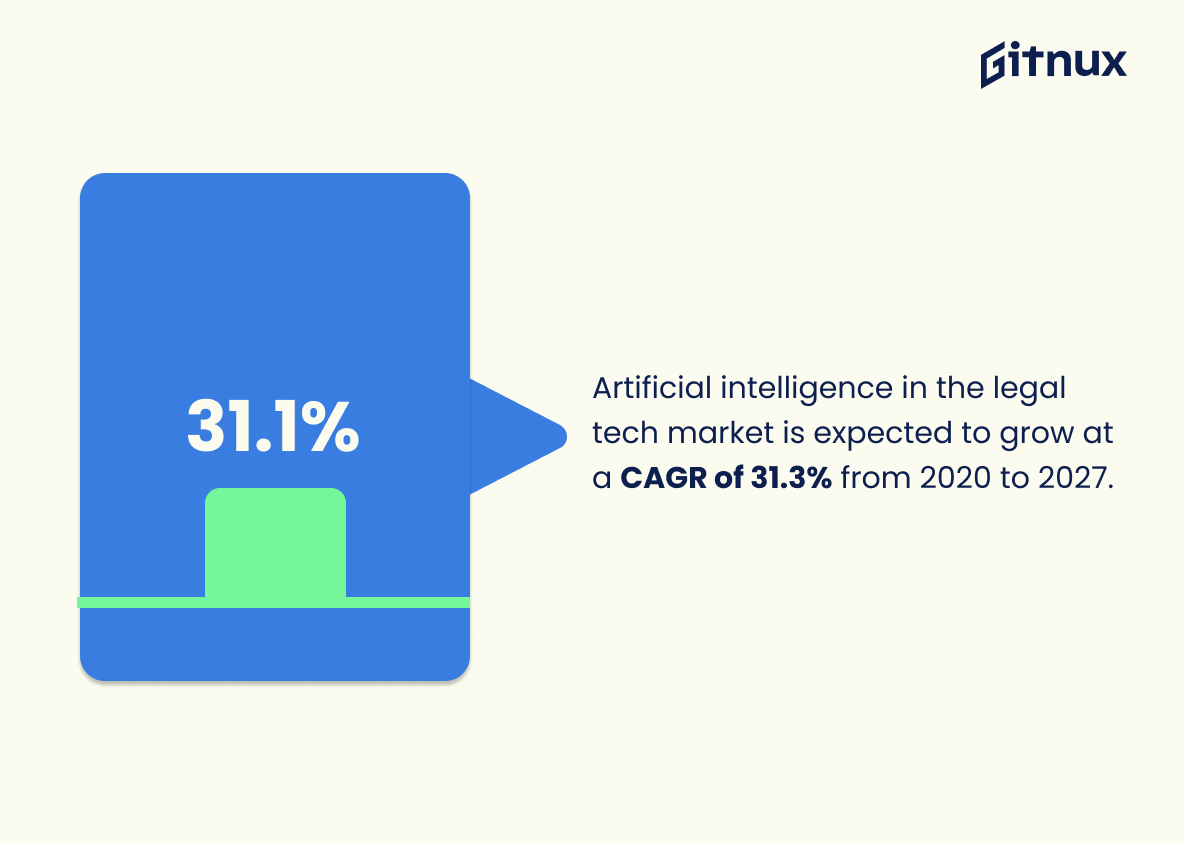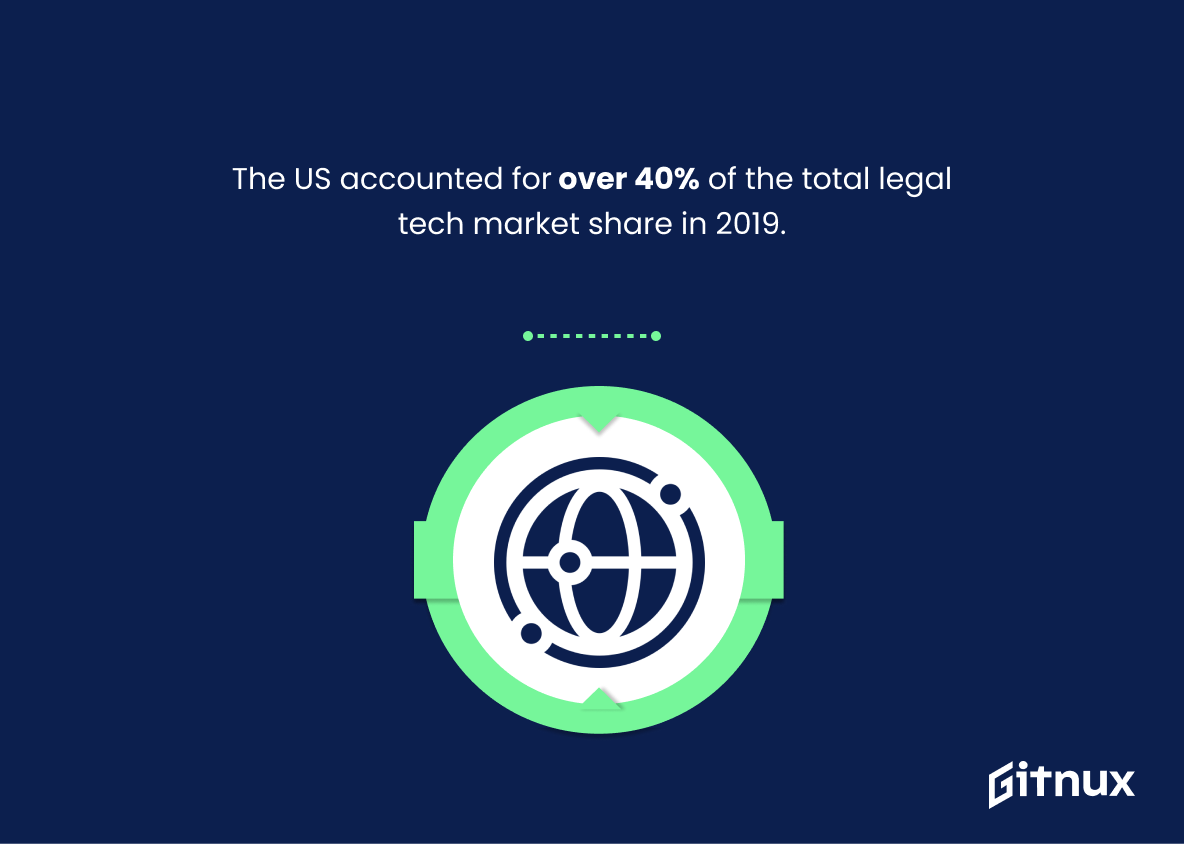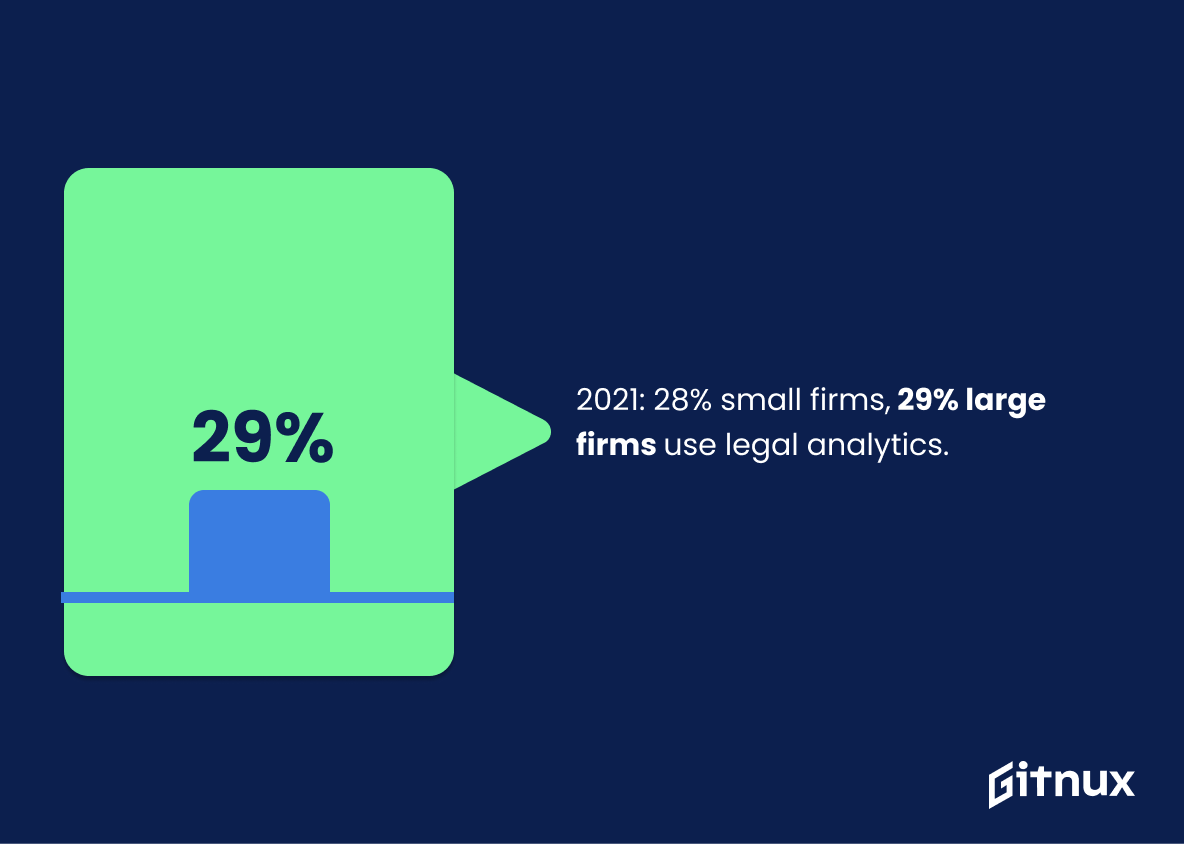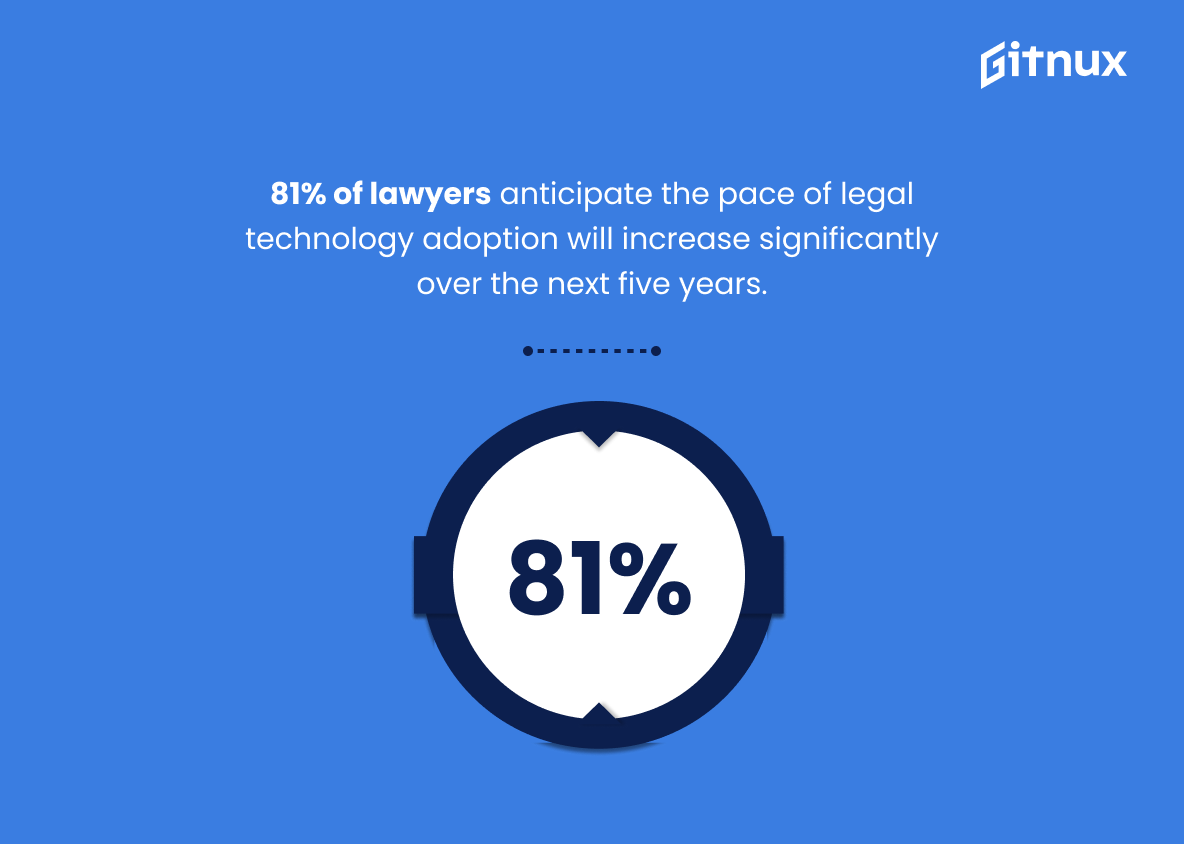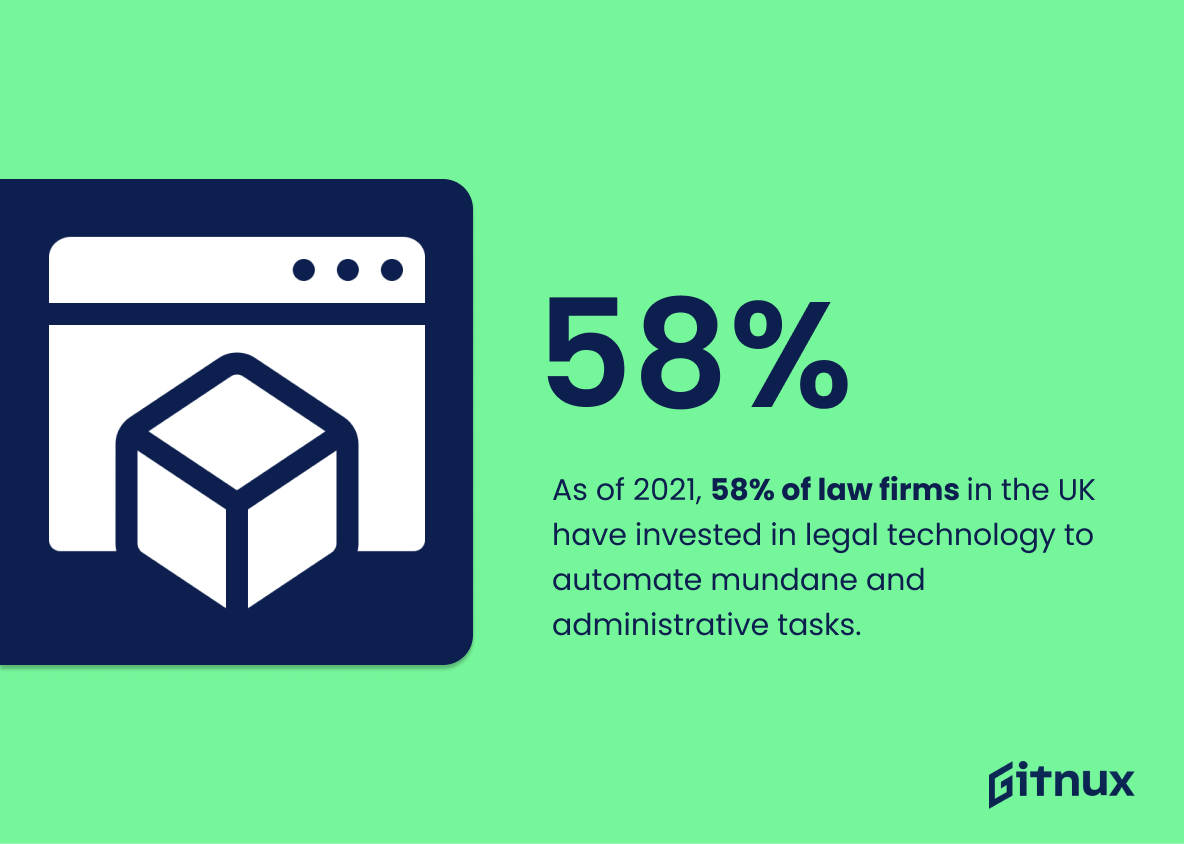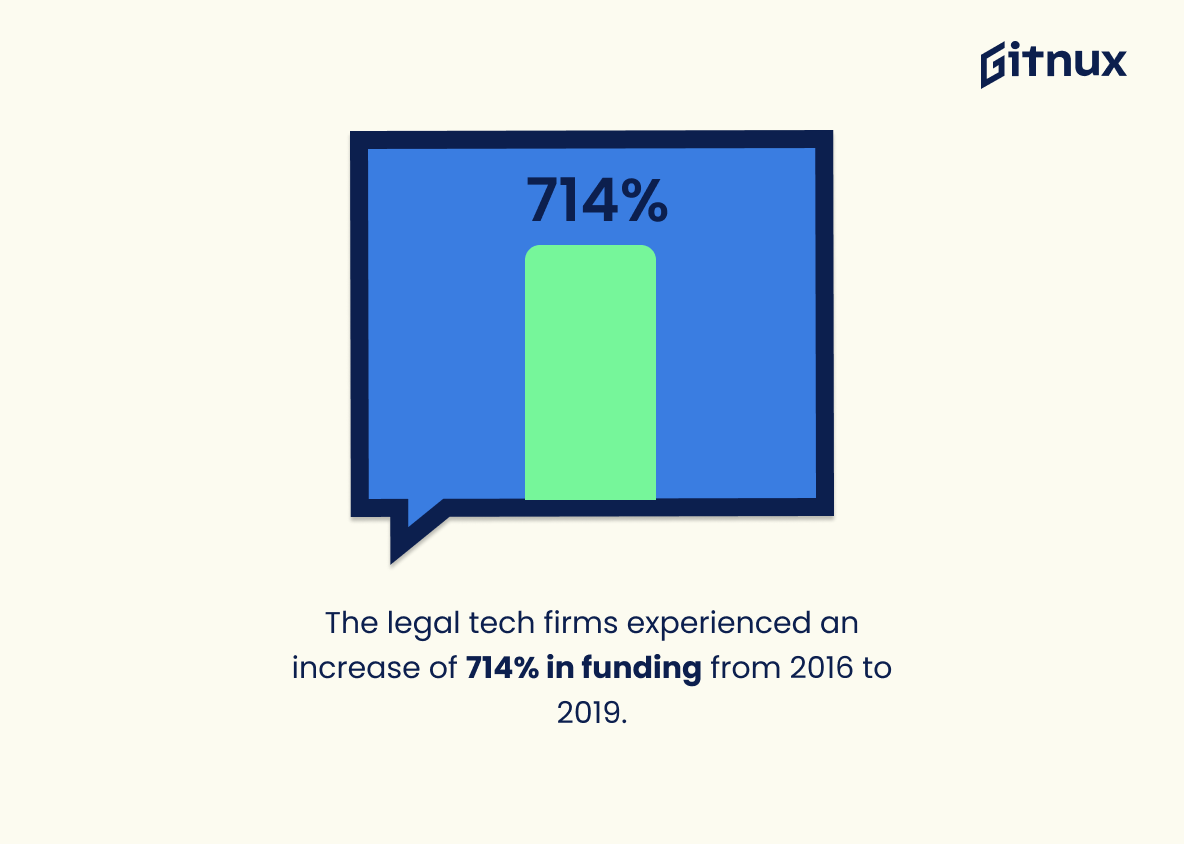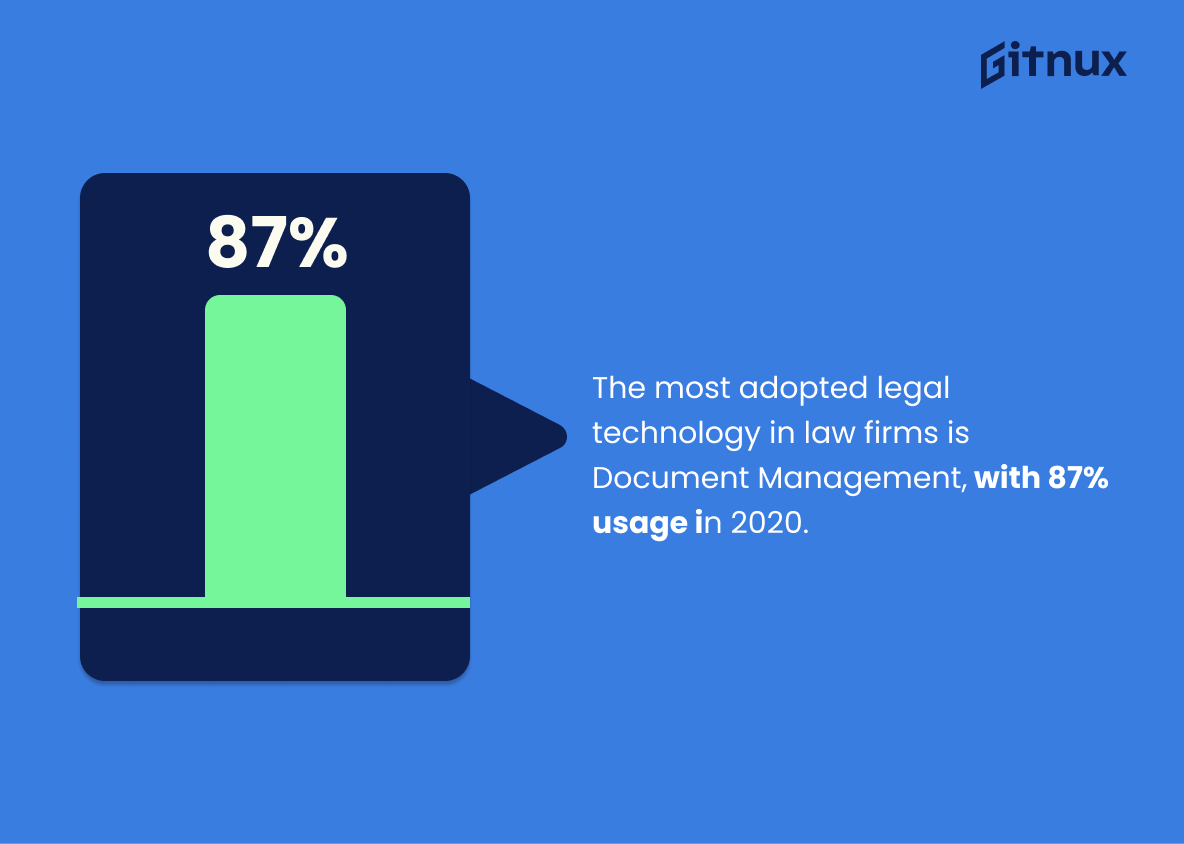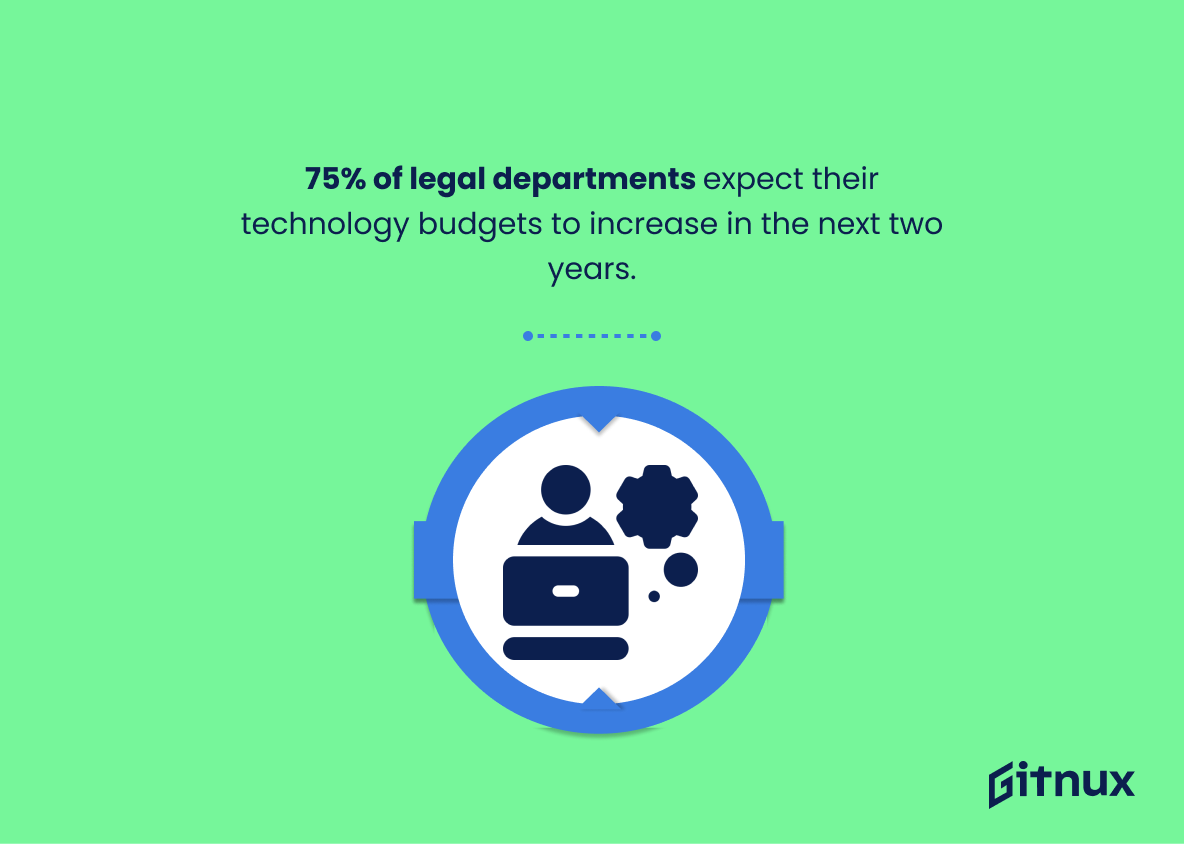Delving into the heart of our digitized world, the intersection of law and technology is experiencing unprecedented growth and transformation. The Legal Tech industry, once viewed as an old-fashioned sector, is now brimming with exciting innovations and disruptive technologies, reshaping the ways legal professionals conduct their business.
This blog post will illuminate the industry’s key statistics, revealing critical insights into its rapid evolution and staggering potential. By understanding these data points and trends, you’ll gain an unparalleled perspective of the vibrant landscape of Legal Tech, empowering you to ride the tide of this thrilling digital revolution. Whether you’re an industry professional, a technology enthusiast, or simply curious, these statistics will open your eyes to the burgeoning world of Legal Tech.
The Latest Legal Tech Industry Statistics Unveiled
Legal tech has attracted more than $1 billion in investment over the last two years.
Having surpassed the monumental threshold of $1 billion in investment in a span of just two years, the legal tech sector is indisputably thriving. This robust financial influx fortifies the industry’s vitality and paints a succinct picture of its rapidly expanding influence and acceptance across the business landscape. Furthermore, it throws the spotlight onto an intriguing narrative of high demand for productivity-enhancing solutions in the modern legal arena.
For anyone eying this booming industry, whether as an entrepreneur, investor or end-user, this statistic serves as a barometer of the immense potential opportunities and rewards that lie within the legal tech field. Essentially, it can be a captivating theme woven through a blog post on Legal Tech Industry Statistics, highlighting the growing interplay between law and technology, fueled by substantial monetary support.
In 2020 alone, legal tech startups raised $1.8 billion in investment.
Unfurling the remarkable journey of legal tech startups in 2020, we stumble upon the staggering figure: $1.8 billion in investment. This numeric revelation persuasively illustrates the burgeoning momentum and faith investors are placing in legal tech, singling it out as a promising realm teeming with innovative solutions.
Serving as a financial barometer, it underscores the rapid growth and potential scalability within the industry. In a blog post examining Legal Tech Industry Statistics, this data point acts as a capital backbone, instigating deeper contemplation about the sector’s accelerating evolution, health, and future prospects.
The global legal tech market size was valued at $15.1 billion in 2021 and is projected to reach $37.9 billion by 2027.
Spilling the figures on the table, it’s pivotal to break down the transformative power of the legal tech universe. In the temporal span of just six years, from 2021 to 2027, the market valuation is expected to gallop from $15.1 billion to $37.9 billion. This meteoric rise serenades with the crescendo of law firms, attorneys, and corporates tuning into the melodies of legal tech.
These figures give us a snapshot of the passionate waltz between law and technology. Serving as a concrete testament to the increasing acceptance and reliance on technology in the legal sphere, it resounds the echo of progression in the hallways of law firms and corporate legal departments worldwide.
In the grand scheme of things, these numbers articulate the narrative of the future – a landscape where artificial intelligence, automation, and other tech advancements not only co-exist with but drive the legal sector. This anticipated market growth serves as a tight-knit forecast of expanding consumer demand, increased efficiency, and profound developments in the legal tech world.
By illuminating the potential for massive growth, this statistic incites a sense of urgency amongst those straddling the cusp of the digital legal frontier. It ignites the call to action, stressing the importance of adaptation and innovation, marking the inescapable reality – legal tech is not just a temporary trend, but a key protagonist in our legal ecosystem’s transformation saga.
Artificial intelligence in the legal tech market is expected to grow at a CAGR of 31.3% from 2020 to 2027.
Highlighting these figures reflects the dynamic transformation the legal tech industry is currently undergoing. Driven by the powerful force of artificial intelligence, an impressive 31.3% CAGR from 2020 to 2027 elevates not just the growth perspective, but showcases the potential magnitude of efficiency, accuracy and cost savings for the industry.
Besides, it insinuates the rapid adaptation and embrace of AI advancements within the legal tech market. Readers of a blog post about Legal Tech Industry Statistics can glean crucial insights about future trends, investment prospects and the directional scale of the evolution to anticipate within this sector.
The US accounted for over 40% of the total legal tech market share in 2019.
Highlighting the fact that the US represented over 40% of the total Legal Tech market share in 2019 serves to underline the country’s dominance and leadership in this arena. It accentuates the role of the US as a significant player and trendsetter in the evolving landscape of the Legal Tech industry. This vital piece of data not only sheds light on regional market predisposition, but can effectively intrigue entrepreneurs, investors, and tech innovators to keep a close watch on the US market, making it a focal point of the blog post on Legal Tech Industry Statistics.
This robust market proportion in the global platform might also suggest the potential opportunities and challenges that other regions might encounter in the future. So the dissemination of this particular statistic is more than just a number, it brands the US as a leading figure in the global legal tech industry.
The litigation software held the largest legal tech market share in 2019, at around 50%.
Reflecting upon this striking statistic, it uncovers the dominance of litigation software in the legal tech industry in 2019. Capturing a mammoth 50% market share, it unequivocally signals its indispensable role and the high degree of reliance placed on it by the legal professionals at that time. Such a revelation is instrumental in comprehending the historical trends and patterns in the legal tech industry, painting a vivid picture of the then market dynamics.
This kind of insight can shape conversations about strategic decision-making, investment potential, or anticipated growth in this arena. The underlying trends suggested by this figure might also spawn an investigation into the reasons for its supremacy and whether it will continue to dominate or give way to emerging disruptive technologies.
In 2021, 69% of law firms reported using practice management software.
This invaluable statistic sheds a transformative gleam on the current trend of digital transition within the legal sector. The adoption of practice management software by 69% of law firms is a outstanding testament to the progressive shift towards innovative technology within the legal system. This unraveling statistic stands as a robust affirmation of the tech industry’s imprint on law firms – denoting both an acceptance and an embracing of digitized practices.
The blog post on Legal Tech Industry Statistics is vividly enlightened by this figure, as it provides readers with a potent measure tracking technological advancement in a profession traditionally slower to modernize. Thus, the resonance of this percentage is inextricably connected to the understanding and discussion around the progressive face of the legal landscape.
In a 2020 Gartner survey, 47% of legal departments have dedicated legal technology support.
Highlighted by the 2020 Gartner survey, the legal tech industry is witnessing a significant transformation with almost half of the legal departments now employing dedicated legal technology support. This points to a growing embrace of technology within the legal sector.
In the realm of a blog post analyzing legal tech industry statistics, this trend underlines the swift digital shift and assists in discerning the trajectory of the technological influence in reshaping legal work. Besides, it could serve as a benchmark for other legal entities who are yet to fully leverage the power of legal technology, reinforcing that tech adoption is no longer optional but a necessity for efficiency.
In 2021, 28% of small law firms (10-49 attorneys) are currently using or implementing legal analytics compared to 29% for law firms with 500+ attorneys.
Analyzing this intriguing statistic, it divulges a captivating trend within the Legal Tech Industry. On one hand, it underscores a digital shift in small legal firms with 10-49 attorneys, where about 28% are embracing or incorporating legal analytics. Comparative to the use of analytics by large-scale law firms with 500+ attorneys at 29%, it underscore’s a pivotal point in the technology curve – size isn’t a determinative factor for tech adoption.
Drilling further, we tap into the realm of how legal analytics can efficiently transmute bulky legal data into actionable insights, making both the practice and business of law more effective and strategic. It compellingly reflects how legal firms, irrespective of their scale, are recognizing the importance of upgrading their traditional practices with legal technology. The one percent differential between smaller and larger firms underscores a converged evolution and a revelation of an industry poised for unified technological progression. Undoubtedly, it offers a fertile ground for tech entrepreneurs to benefit from the still fresh market dynamics.
Conclusively, this particular statistic decisively paints the portrait of a legal tech industry that is no longer a prerogative of elite, large-scale law firms but an accessible tool ripe for adoption across the board. It’s a testament to the level playing ground that technology avails, creating a more uniform, progressive, and efficient legal landscape.
81% of lawyers anticipate the pace of legal technology adoption will increase significantly over the next five years.
Unraveling the depth of this statistic, it magnifies a transformative shift in the legal landscape, echoing the sentiment of lawyers that legal technology is reshaping the sector. With a whopping 81% of them forecasting a substantial acceleration in the uptake of legal technology, this suggests that the legal tech industry is poised for substantial growth in the coming five years. In the context of a blog post about Legal Tech Industry Statistics, this piece of data stands as a loud and clear predication, painting a future where law firms inevitably lean towards tech-integration.
Moreover, it underlines a sense of urgency and the inevitability of change, hinting at opportunities for law firms to stay competitive, and tech companies to innovate and fulfill this increasing demand. This evolving landscape is expected to breed efficiency, cost-effectiveness, and enhanced legal services. Hence, not only does this statistic forecast industry trends, but it also provides a yardstick for investors, startups, and established law firms to strategize their moves in this accelerating industry.
As of 2021, 58% of law firms in the UK have invested in legal technology to automate mundane and administrative tasks.
Highlighting the trend that 58% of UK law firms invested in legal tech as of 2021, the statistic provides a compelling lens into the accelerated embrace of digital innovation within legal circles. It reflects the shifting tides within the industry, underscoring technology’s pivotal role in modernizing traditional legal practices.
This recognition of tech-adoption indicates how law firms are increasingly valuing efficiency, as automation of routine tasks frees up time for more complex, value-added work. Thus, this statistic is not merely an interesting footnote, but a key marker on the transformational roadmap of the legal industry, painting a picture of evolution intrinsic to understanding the landscape of Legal Tech Industry.
The legal tech firms experienced an increase of 714% in funding from 2016 to 2019.
A colossal 714% surge in funding for legal tech firms from 2016 to 2019 paints a picture of a swiftly evolving landscape in the industry – a veritable gold rush for innovation. It illuminates not only the burgeoning investor confidence in the sector, but also signals a significant transformation in the broader legal domain, hinting towards breakthroughs propelled by advanced technologies.
With such sky-high increases in funding, there’s an obvious expectation of new solutions and a profound shift in how legal procedures could unfold in the near future. As the numbers impel the story, we’re watching a legal industry ripe for disruption and exciting opportunities.
Since 2016, about $3.6 billion has been invested into legal technology around the world.
Highlighting the investment of $3.6 billion into legal technology since 2016 underscores the massive financial interest and confidence this industry has attracted globally. This impressive figure signals the tremendous growth and potential of this sector, spotlighting its importance for the future of legal operations. For blog readers, this paints a vivid image of the investment landscape, displaying the promising prospects of the legal tech industry, and the unambiguous endorsement of its innovative potential by substantial financial backers.
The most adopted legal technology in law firms is Document Management, with 87% usage in 2020.
Highlighting the towering adoption rate of Document Management, a staggering 87% in 2020, aids in painting a colorful snapshot of the changing tides within the legal tech industry. It embodies testament to how technology is progressively seeping into the traditional fibers of law firms, challenging conformist models and altering their everyday operations.
Moreover, with Document Management reigning supreme in adoption, it underlines the priority firms are assigning to efficient and organized information handling, reflecting a pivot towards smarter and more streamlined workflows. This is a powerful stroke in the landscape of the legal tech industry, offering insights for the contemporaries and catalysts for tech vendors to innovate, align, and meet the industry’s rising demands.
75% of legal departments expect their technology budgets to increase in the next two years.
Unearthing this intriguing nugget of information reveals an exciting trend within the sphere of legal departments. It’s like a beacon illuminating the path of technological evolution in this sector. Given that three quarters of legal departments anticipate growth in their technology budgets over the next couple of years, we uncover the rising wave of technology adoption in this sector. It’s not just an abstract number but a bold statement about the future of the legal tech industry. As budgetary allocation is often an accurate precursor to actual industrial shifts, this statistic shines a light on the blossoming intersection between law and technology. This forecasted surge hints at an imminent revolution in legal operations, court-room proceedings, client services and document management driven by technology. Hence, every legal tech enthusiast, entrepreneur or investor should keep their eyes peeled and focus not just on the legal tech of today, but the unfolding vista of tomorrow.
Legal tech companies grew fivefold in only three years, from 51 in 2017 to more than 250 in 2020 in all of Europe.
Witnessing an impressive fivefold growth of legal tech companies – leaping from a mere 51 in 2017 to an astounding count of over 250 by 2020, these figures encapsulate an undeniable boom in the European legal tech scene. In the context of understanding the landscape and potential of the legal tech industry, this growth rate serves as a potent indicator. It instantly highlights a flourishing market, thus signifying increased innovation, competition, and opportunities within this realm.
Moreover, this rapid expansion could be suggesting a rising acceptance and demand for legal tech solutions across Europe, further hinting at the industry’s promising future. This information echoes an invitation not just to potential investors eyeing the sector but also to aspiring entrepreneurs looking to disrupt the space. Furthermore, the trend can prompt even traditional legal professionals to embrace these newer technologies, encouraging them to stay abreast with the industry’s growth and evolution.
Hence, this statistic is akin to a beacon illuminating the profound impact and transformative potential of technology on the European legal industry in a relatively short time span.
Legal services firms using CRM software saw an increase in sales by up to 29%, and productivity increased by up to 34%.
Firmly nestled amidst the intricate fabric of the Legal Tech Industry statistics, is a gem—a pulsing beat that whispers a promising trend. Imagine, the power of Customer Relationship Management (CRM) software soaring sales for legal services firms by an impressive 29%. Even more tantalizing? A turbo-boosted productivity jump of up to 34%. These figures aren’t just numbers, but the sparkling indicators of unbridled potential. They’re the milestones of an evolving industry, shaping the narrative and setting a precedent for leveraging technology in delivering legal services.
This statistic is a beacon, illuminating not only the power of CRM software, but also the remarkable rewards that tech-adoption brings into the legal field. It’s a testament to the dawn of a new era—an era where technology is no longer an option but a necessity in achieving efficiency and growth in the Legal industry. With such promising results, one wouldn’t be mistaken to claim that CRM could well be the secret weapon for legal firms in the race to market dominance.
64% of general counsel will spend more on technology in 2022 than they did in 2021.
Presenting an intriguing revelation, the robust statistic – ‘64% of general counsel will spend more on technology in 2022 than they did in 2021’ – paints a vivid picture of the thriving legal tech industry. This paints a future landscape where integration of technology within the legal sphere is not a mere probability, but a distinct inevitability. This could potentially trigger a transformation in case handling, data management, legal research, and even in client-lawyer interaction.
Such a trend, where general counsel leverage advanced tools and digitization, amplifies the necessity for tech companies to step up their game, coming up with user-friendly, innovative solutions. This surge in tech adoption, further, indirectly speaks volumes about the emerging opportunities for IT professionals within the context of the legal industry – a symbiotic relationship of sorts. It shows technology is no more just an enabler, but is becoming a key strategic partner in redefining the courtroom’s future.
In 2020, cybersecurity was the most significant area of technology spending for law firms, with 46.1% of respondents reporting this factor.
Unwrapping the depth of this statistical revelation, it brilliantly illuminates the intense focus the legal tech industry is placing on cybersecurity. With 46.1% of law firms in 2020 investing heavily in fortifying their technological defenses, it paints a vivid picture of the sector’s evolving landscape. The magnified importance of safeguarding sensitive data amidst increasing cyber threats underscores the high stakes at play.
In the context of a blog post about Legal Tech Industry Statistics, this nugget of information not only highlights the industry trends but also unveils the prudence and strategic priorities of law firms in the digital era. It exhibits the immense weightage cybersecurity commands in the technological expenditure of law firms—a testament to its significance in this highly sensitive and confidentiality-driven industry.
Only 7% of legal departments reported using AI tools in their everyday work in 2020.
Peeling back the layers of this rather intriguing statistic, we unearth a rich terrain of implications for the Legal Tech Industry. The figure, a seemingly modest 7% of legal departments reporting the use of AI tools in their everyday work in 2020, presents itself as a potent indicator of the nascent stage of AI integration in this sector.
On one hand, this statistic subtly unveils a vast and practically untapped market, teeming with potential for growth and innovation in an industry traditionally known for its resistance to change. It showcases how much room there is for expansion and adoption of legal tech AI tools in the professional world.
On the other hand, it flashes an interesting challenge before tech corporations- the exigency to formulate persuasive elucidations upon the practical benefits of AI adoption in legal departments. This highlights a communication gap that needs to be crammed by elucidating the assumed intricacies and demonstrating the real-life applications of AI to sway a larger fraction of the legal industry.
Indeed, this particular statistic serves as a prism, refracting perspectives about the technological landscape of the legal industry, the potential it holds, the challenges it posits, and the direction it is headed in.
Conclusion
In reviewing these compelling statistics and emerging trends, it is abundantly clear that the legal tech industry is on an undeniable upward trajectory. The pervasive and rapidly evolving usage of technology in the legal sphere is proving to be a game-changer, significantly transforming traditional legal processes and offering invaluable advantages in terms of productivity, efficiency, and cost-effectiveness.
As we move forward, law firms and legal professionals who embrace these advancements would be better placed to streamline their operations, enhance decision-making, and serve their clients more effectively. Indeed, being cognizant of these statistics and staying updated with the latest developments in legal tech might just be the distinction between merely surviving or thriving in the modern legal landscape.
References
0. – https://www.www.reportsanddata.com
1. – https://www.www.jdsupra.com
2. – https://www.www.relativity.com
3. – https://www.www.gartner.com
4. – https://www.www.globenewswire.com
5. – https://www.www.lawgazette.co.uk
6. – https://www.www.financesonline.com
7. – https://www.lawtomated.com
8. – https://www.www.technavio.com
9. – https://www.www.iltanet.org
10. – https://www.www.abajournal.com
11. – https://www.www.bcg.com
12. – https://www.reportocean.com
13. – https://www.legal.thomsonreuters.com
14. – https://www.www.alliedmarketresearch.com
15. – https://www.www.clio.com
16. – https://www.www.businesswire.com
